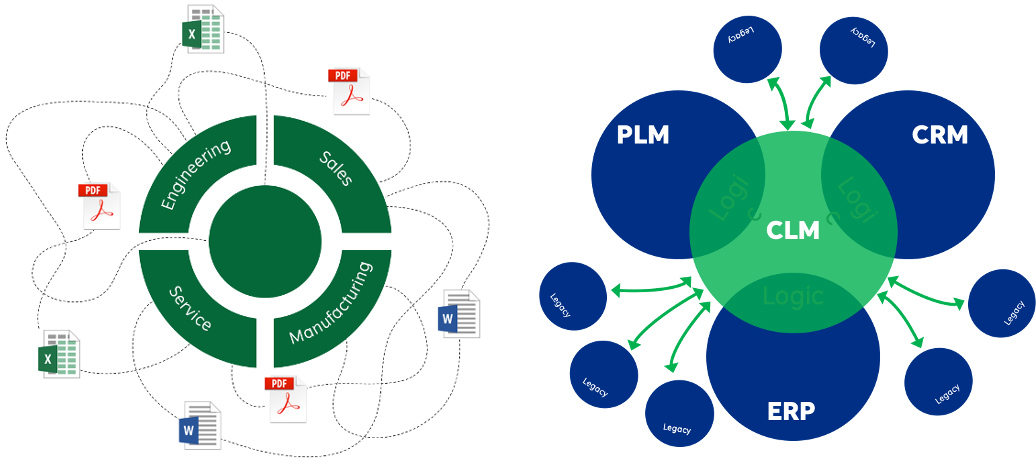Why CPQ IS Not Enough
09/24/2020
IpX - Institute for Process Excellence

Picture this scenario. Your company's sales team is in the field. They are visiting a potential
customer. All the important figures are there, sitting around the conference room table. Your sales
lead is on their laptop, sharing the screen to the main projector. Running, is the lightweight CAD viewer and composer software installed by your company's IT department. The sales lead never got
any training on it, but the software is easy to use thanks to the building blocks created by
Engineering. The sales team is listening to the customer, dragging and dropping bits and bobbles,
panning and zooming around the screen, and fully impressing the customer with how your company
can create a customized solution to fit their exact needs, all in real time. The customers are all sitting
on the edges of their seats, captivated by how smoothly this experience has been. The conversation
ends, and on the screen is a fully rendered solution. Everyone shakes hands and the sales lead
presses send. The custom configuration is uploaded to the corporate servers. Now the real fun
begins.
In a best-case scenario, the Engineering Manager reviews the work done by the sales team. In a
worst-case scenario, that configuration is automatically entered straight into ERP and work orders are being expedited to meet this unrealistic deadline set by the sales team. Either way, expletives are
flying around the office.
"Who approved this configuration?"
"We can't build this."
"This will never work!"
"They promised it by when?"
History of CPQ
CPQ - Configure, Price, Quote - software started at about the same time as the personal computer,
in the 1980s. As technology improved, so too did the software. The above scenario is exactly why
CPQ software was created - to allow the sales teams to quickly put together a quote for the
customer that is accurate and consistent among the growing worldwide sales teams. And, within that
context, CPQ works great, so long as the rules that were defined in the CPQ system were setup
correctly. But as technology grew, datasets moved from 2D to 3D to virtual; and as mass
customization [1] becomes the new normal, the ability to properly configure a product requires more
and more rules to ensure compatibility of design element options. And that is where CPQ hits its
limits.
The Fallacy of CPQ
While it may be named a "configurator," CPQ is not enough, both in terms of making the sale or in
terms of driving revenue for the company. Why? Because as the example scenario shows, the ability
of the sales team to create a viable configuration on the spot is highly dependent upon the building
blocks that have been designed into the system, adequate training on using the tool, product
knowledge, and current production capacity or schedule. In other words, simply dragging and
dropping some pictures together, while it may look good, does not guarantee success. That is why
many early CPQ workflows mandated review by Engineering before the order was processed.
In today's world, that workflow is too slow. Turnaround times are constantly challenged and any
way to trim a few days or weeks off the process means faster time to market and more revenue for the bottom line. Bypassing an Engineering review and moving straight into production does just
that. That is, until the configuration that the sales team developed cannot be built or does not
function. Then, instead of fast and efficient engineer-to-order workflow, the company is stuck in a
loop of corrective action and production delays. Not exactly the promise that CPQ offers, nor the
promise that the sales team provided the customer. And this does not include consideration for
scheduling conflicts with other committed delivery dates.
Similarly, populating legacy configurators with increasingly complex sets of rules takes a long time of
up-front processing and labor. To handle this part of the process, configurator engines have
matured, moving from simple rules-based selections to constraint satisfaction engines to compile based
configurators [2]. Regardless of the method, human intervention is required to define what
options and variants are compatible with each other. However, it gets increasingly difficult for a
human to accurately define every possible viable combination as complexity increases.
In the meantime, sales automation has grown as well. The forward-facing tools have improved.
CRM is now the forefront in managing client interactions and CPQ remains, for the most part,
considered a back-office tool. Yet, as generations continue to expect more from the online buying
process, the ability to customize their own product is demanded by consumers. But this trend is not
limited to B2C shoppers, B2B customers expect the ease and convenience of online buying, too.
These trends extend across industries, from computer buying to car buying to machine component
buying. Out of consumer demand, CPQ has become part of the forward-facing buying experience
and creating a lifecycle of its own.
Configuration Lifecycle Management
 A Configuration Lifecycle Management system replaces the error prone manual exchange of information between functional groups
in an organization with an automated integration of rules & dependencies with logging and traceability changes.
A Configuration Lifecycle Management system replaces the error prone manual exchange of information between functional groups
in an organization with an automated integration of rules & dependencies with logging and traceability changes.CPQ on its own is no longer sufficient to meet the evolving customer requirements. The disparate
systems in use by CRM, CPQ, PLM, and ERP each has its merits but does not provide a single
source of truth. The sales team is using the latest data on their CRM system, but it may not have
been updated to the latest engineering data resident within PLM. And CPQ often bypasses PLM and
works with the sales tools that input directly into order processing, typically the domain of ERP.
What is needed is a Configuration Lifecycle Management (CLM) system that integrates each of these
systems and brings with it a single source of truth.
A properly implemented CLM system defines the rules from sales & marketing requirements
matching (Market Intent) what is being offered to the customer, these rules are linked to Engineering, who own the data and understand the functional interactions of options and variants.
(i.e. bill of material). The CLM system takes those rules and allows the sales teams to create custom
configurations for the users that they know have been approved and are manufacturable. New
configurations can be defined on the fly and be fully structured in PLM. The link from CLM to ERP provides the sales team with a realistic expectation of when the system can be built, even if it has
never been built before.
Changes made to one system are synchronized among all the business enterprise tools. As
Engineering develops new products or new options, those rules propagate into CLM. A robust
change and configuration management process ensures change impacts are defined, thereby
identifying all data that needs to be updated including work orders and build sheets. As the sales
team creates these new options, they can be confident that a robust configuration management
process enabled by a tool like CLM guarantees a flawless sales order and a satisfied customer.
The New Story

Let us look at our story again, but this time with CLM.
The customer begins by visiting the supplier's website. The website received all valid combinations
of the Products from the CLM configurator. From the website, the customer uses the web
configurator to select the product and options they desire. This could involve "Guided Selling"
leading the customer to special packages or campaigns. After submittal of the order, the integrated
enterprise tools are validating the requested configuration with configurations that have already been
defined. Upon validation the order is expedited to production, the ERP system is automatically
updated with the order, and the ERP system provides a delivery date to the customer based on real
time production schedules. On time delivery is assured. Customer satisfaction guaranteed.
If the CLM configurator allows for customization of the products, the website configurator will
allow the customer to enter the data. This could be size of the product - for example, the length of a
crane or size of a tent. After submittal of the order, the sales team or application engineers get
notified of the order and follow up with the customer, clarifying that the selected options fit the
customer's intended application and use case. In the meantime, the integrated enterprise tools are
comparing the requested configuration with configurations that have already been defined. If one
exists, the order is expedited to production and the ERP provides a delivery date to the customer
based on real time production schedules.
If a configuration has not been built before, Engineering is notified to verify and release the new
product structure, creating any new datasets, as needed. The ERP system is automatically updated
with the order and schedules the order for production providing feedback to the customer. On time
delivery is assured. Customer satisfaction guaranteed.
While this utopian future seems very similar to the original story, it is only feasible because of robust
processes and enabling tools. Without good change management and Configuration Lifecycle
Management, none of this would be possible. The reality is, employees spend countless hours
verifying and validating spreadsheets and manually updating data, often creating duplicate
information because it is easier than searching for an existing configuration, only to find themselves
suffering from cost overruns while they apologize to the customer for being late on delivery - again.
If you find yourself in that last situation, maybe it is time to see if Configuration Lifecycle
Management is right for you.
For more information about CLM visit
https://configit.com/solutions/clm/.
Download the PDF Here
References
[1] M. E. Dollarihide, "Mass Customization," Investopedia, 04 SEP 2020. [Online]. Available:
https://www.investopedia.com/terms/m/masscustomization.asp. [Accessed 07 SEP 2020].
[2] Wikipedia, "Configure, Price and Quote," 01 APR 2020. [Online]. Available:
https://en.wikipedia.org/wiki/Configure,_price_and_quote. [Accessed 04 SEP 2020].


